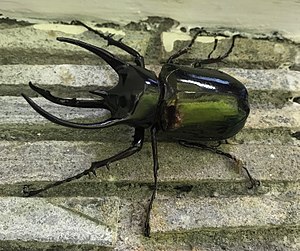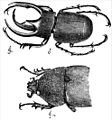Atlas beetle
| Atlas beetle | ||||||||||||
|---|---|---|---|---|---|---|---|---|---|---|---|---|

Atlas beetle♂ ( Chalcosoma atlas ) in a botanical garden on Java |
||||||||||||
| Systematics | ||||||||||||
|
||||||||||||
| Scientific name | ||||||||||||
| Chalcosoma Atlas | ||||||||||||
| ( Linnaeus , 1758) |
The Atlas beetle ( Chalcosoma atlas , originally described as Scarabaeus atlas ), also known as the three-horned beetle, is a species from the giant beetle subfamily .
Occurrence
The species inhabits the forests of Southeast Asia below 1200 m above sea level. NN , particularly in Indonesia and Malaysia has spread the Atlas beetle. Its distribution areas overlap with those of other representatives of the genus Chalcosoma - in particular with Chalcosoma caucasus - so that there are occasional hybrids .
description
The Atlas beetle reaches a body length of 35–115 mm (measured with horn), with the males being larger than the females. The wings are smooth and have a brownish-bronze color. In contrast to the females, the males have three horns, one of which is on the head (cephal) and two on the prothorax . The cephalic horn is wider than other members of the genus Chalcosoma and has a flat, noticeable tooth. The two horns on the prothorax curve slightly downwards. As is usual with other representatives of the giant beetles, these horns are used by the males among themselves when fighting for females in order to then mate with them.
A dimorphism can be observed in the males : On the one hand there are specimens with a large physique (average length 65.0 mm) and long horns (average 34.6 mm), on the other hand smaller ones (average body length: 56.6) mm) observe individuals with short horns (average 15.4 mm). This suggests different pairing strategies of the two manifestations.
Way of life
The beetle larvae develop in dead palm wood, whereas the adults feed on coconut palm blossoms and branches of the coffee bush. The beetle develops through three larval stages.
The larva corresponds in type to that of the grubs . It is known for its relatively aggressive behavior, which is typical for the larvae of the representatives of the genus Chalcosoma . When touched, the larvae tend to defend themselves by biting with the pronounced mandibles . According to unconfirmed reports, the larvae are said to be cannibalizing when there is not enough food available.
The species is host to the parasitic dagger wasp Megascolia procer , which paralyzes the beetle with a poison.
Historical names
The Atlas beetle is said to have got its name because of its huge size (see mythological figure Atlas ). In the 18th century the Atlas beetle was also referred to as the three-horned breastplate beetle, or by Swammerdam in his Bible of Nature as the flying elephant .
photos
Web links
Individual evidence
- ↑ a b Kazuo Kawano: Character Displacement in Giant Rhinoceros Beetles . In: The American Naturalist . tape 159 , no. 3 , March 2002, p. 255-271 , doi : 10.1086 / 338512 , PMID 18707378 .
- ↑ a b Chalcosoma Atlas. In: naturalworlds.org. Retrieved September 22, 2018 .
- ↑ GO Bedford: Description of the larva of Chalcosoma atlas (L.) (Coleoptera, Scarabaeidae, Dysnastinae) from Malaysia . In: Bulletin of Entomological Research . tape 66 , no. June 2 , 1976, p. 189-193 , doi : 10.1017 / S0007485300006623 .
- ↑ Legacy of the Titans: The Three-Horned Beetle. In: aqualog.de. June 14, 2013, accessed September 22, 2018 .
- ^ Atlas Beetle. In: animalcorner.co.uk. Retrieved September 22, 2018 .
- ↑ Tom Piek (Ed.): Venoms of the Hymenoptera. Biochemical, Pharmacological and Behavioral Aspects . Elsevier, 2013, ISBN 978-1-4832-6370-0 , pp. 173 ( limited preview in Google Book search).
- ^ Friedrich Heinrich Wilhelm Martini : General history of nature in alphabetical order. Part 3, Pauli, Berlin 1777, p. 470 ( digitized version ).






